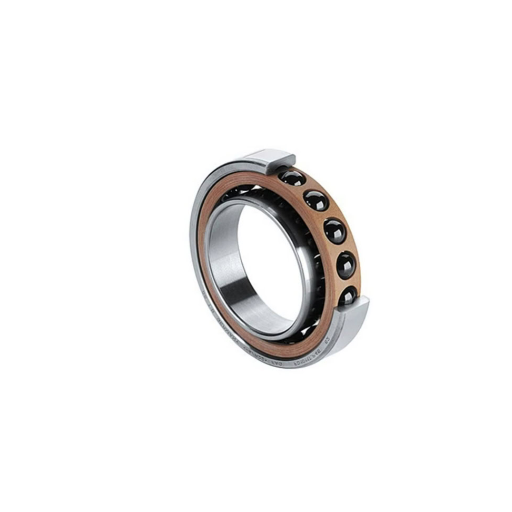Angular contact ball bearings are critical components in the design and operation of precision machinery, offering exceptional performance in handling both radial and axial loads simultaneously. These bearings are engineered to meet the demands of high-speed, high-precision applications, making them indispensable across industries such as automotive, aerospace, manufacturing, and robotics. By understanding their structure, functionality, and proper implementation, engineers and technicians can optimize machine efficiency and longevity.
What are the advantages of using angular contact ball bearings in machines?
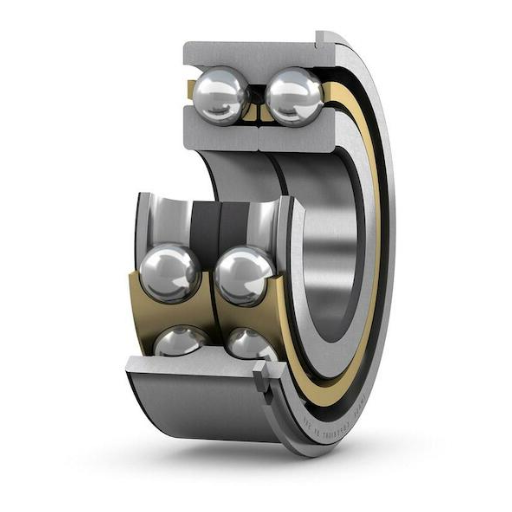
High-speed capabilities and precision
Angular contact ball bearings are strong swivel bearings that can endure high speeds and friction while still maintaining a high level of accuracy and efficiency. This makes them great mechanical components. The design and the strong construction of the ball bearings give them the ability to withstand both radial and axial loads thus providing the bearings with stability at high speeds while reducing noise and vibration.
- The angle of Contact: Ranges from 15 to 40 degrees and influences the bearing’s ability to take on axial loads. Angles more slightly increased generally increase the said capacity while a decrease increases the performance of bearings at speed.
- Speed Limit: Construction type, lubricants, and cell structures fix a general limit on a bearing’s top RPM. Most models are expected to spin to around 20,000 revolutions per minute, with some even lower.
- Accuracy of Runout: This feature is of utmost importance to precision CNC parts and aerospace parts because angular contact bearings allow angular errors to be rotationally angled much more precisely.
- Construction Materials: Speed performance improvements, wear, and thermal expansion resistance, as well as other benefits are made possible by using cutting-edge materials like ceramic balls or heat-treated steels.
These attributes make angular contact ball bearings indispensable in environments where operational reliability and efficiency are paramount. Proper selection, alignment, and lubrication of the bearings are necessary to fully capitalize on their high-speed and precision advantages.
Ability to support combined radial and axial loads
Angular contact ball bearings are specifically designed to support combined radial and axial loads due to their unique internal geometry. The contact angle, typically ranging from 15° to 25° depending on the design, plays a critical role in determining the bearing’s ability to handle axial loads. A larger contact angle increases the axial load-carrying capacity but reduces the radial load capability, making the selection of the contact angle application-specific.
- Dynamic Load Rating (C): This is an indicator of the level of load a bearing will sustain but only within an active structural application. The determinants of this factor are the size, the shape of inside components, and the type of materials used in constructing the bearing.
- Static Load Rating (C₀): This is the maximum load a bearing is expected to carry but only up to the point when permanent deformation occurs with no motion.
- Maximum Speed: Due to the materials selected and hearing from chosen dispersants, manufacturers tend to set averages of the angles usually exceeding what basic tackle angles can reach for ball bearings.
- Axial Load Carrying Capacity: For turbomachines or spindles, a contact angle or bearing or controller of 25 degrees tends to be sufficient.
- Radial And Axial Load Distribution: These bearings are intended to carry loads equally about the inner and outer rings, and a correct amount of preload is applied to them.
For reliable operation of journal bearings at a higher load, proper alignment of the bearings, proper lubrication, or relevant contact angle and bearing load rating when choosing a bearing is of great importance to the performance of the bearing working in the designed application.
Comparing angular contact bearings to other bearing types
The design, performance, and application of angular contact bearings differ greatly from other types of bearings. Angular contact bearings allow for the simultaneous application of both axial and radial loads due to the angle at which the races are cut therefore having a greater axial load-carrying capacity than the deep groove ball bearing. However, the simplicity of the design enables its application where a deep groove ball bearing carries only moderate axial loads, while the angular contact type excels in applications where high axial loads are to be encountered along with precision requirements, such as spindle systems.
In the comparison with cylindrical roller bearings, the major difference is that in the case of the angular contact type the combined loads are to be accommodated. Although providing high rigidity and being optimized to radial loads allows cylindrical roller bearings applications, they are not as efficient where axial loading is required. With adjustable preloads and defined contact angles for angular contact bearings more dynamic applications such as motors or turbines can be accommodated.
- Contact Angle (α): Affects axial load capacity. 15°, 25°, and 40° are the standard angles, the larger the angle the greater the axial load supported.
- Dynamic Load Rating (C): Determines the ability of the bearing to withstand dynamic forces over time.
- Preload Value: This feature helps in ensuring stiffness and minimizing movement, and is important in precision applications.
- Lubrication Requirements: Essential for reducing wear and maintaining operational stability.
- Speed Rating ( n ): Defines the maximum operational speed for specific designs.
By analyzing these relative to the requirements of your application, the choice between angular contact bearings and other types can be justified clearly and effectively.
What are the different configurations of angular contact ball bearings?
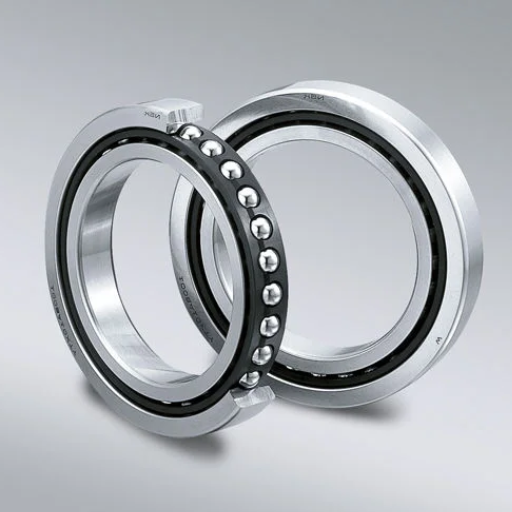
Single-row vs. double-row angular contact ball bearings
Angular contact ball bearings can be distinguished into two groups: single-row and double-row. Since the primary distinction lies in their load-carrying capabilities and design configurations these bearings can also be in the form of multi-row angular contact ball bearings.
- Single Row Angular Contact Ball Bearings: The design of these bearings promotes their use in situations where there is a need to apply combined loads that are unidirectional. These bearings have internal parts that necessitate the use of a second bearing on the side to which the load is not applied. the single row of ball bearings design has its advantages because of the reduction of friction as compared to the double row when applying them in higher speeds.
- Contact angle (α): Usually to be able to accommodate such axial loads contact angles can be between 15 to 40 degrees.
- Speed Rating: This tends to be higher with single rows of ball bearings than the double owing to the lesser relative friction present to the internal contents.
- Axial Load Capability: The maximum amount of axial load to be countered stands to be unidirectional.
- Double Row Angular Contact Ball Bearings: In most designs of double-row angular contact ball bearings, there exist two single-row ball bearings arranged back to back within the structure which enables the application of axial loads in both directions, as well as radial loads. They are suitable for applications with a limited footprint in which a pair of single-row bearings cannot be utilized.
- Contact angle (α): To take full advantage of an enhanced ability to withstand axial loading in both directions, the correct contact angle is predetermined.
- Load capacity: Incorporating a double row of angular contact ball bearings translates into an increased ability to bear both axial and radial loading in comparison to a single-row bearing.
Double row bearings have a greater width which can be a restriction in tight or limited working areas. Each type has its specific application for load, speed, and space, so one must fit the bearing to the working conditions in which it will be used.
Back-to-back arrangement and its benefits
The double back (DB) configuration of bearings allows for mounting in both the axial and radial directions. In this arrangement, two angular contact ball bearings are mounted back to back with their outer ring facing back to back forming a load path in the shape of a “V”. This arrangement offers greater stiffness which is advantageous in operating conditions where the load exhibits moment torque or at an angle concerning the spindle such as a machine tool spindle or a robotic arm.
- Capacity of axial load: The axial load complement precisely such that the load is shared between the two bearings distributed at an equal level which enhances the performance of a cycloidal rotor in case of bidirectional axial load.
- Radial constructed stiffness: The distance between the bearings will allow for greater radial support improvement.
- Contact angle: in this arrangement, the contact angle α is greater resulting in enhanced axial rigidity though there is the need to compromise rotational speed slightly, hence the relevance of the angle suited for a particular task.
- Distance between the bearings: The distance between the spacers is larger which means that the bearings will be able to better withstand tilting moments which enhances the working characteristics of the tool when the load curve is nonsymmetrical.
When these are considered during the design and selection of the joints, the double back-to-back arrangements of the joints offer an effective wrapper for operations that require joint stability, precision, and strength.
Precision angular contact ball bearings for specialized applications
Precision angular contact ball bearings are created for applications where speed, load-carrying capacity, and accuracy are essential. These bearings are used specifically in the fields where higher rotational precision is required like in, CNC machines, aerospace devices, and medical devices.
- The Contact Angle(α): These are designed with an angle of either 15, 25, or 40 degrees. A higher contact angle enables higher axial loads, on the other hand, a lower angle enhances speed and accuracy.
- Preloading: To ensure the bearing deflection is reduced and system rigidity is improvised different levels of preloading light, medium, or heavy are selected depending on the load and operational requirements.
- Material Composition: The maximization of load-carrying capacity, lowering thermal expansion and friction is achieved through ceramic hybrids or steel of premium quality.
- Lubrication: In the case of grease or oil lubrication the choice of either will always depend on the temperature range and operational limits of the environment the bearing will be operating in.
- Load Capacity: C and Ca the radial and axial load ratings are crucial to ensure the bearing can go under the foreseen forces without damaging flexibility from the load.
Each of these should match the precise requirements of the application to ensure that the bearings provide the necessary stability, durability, and accuracy. By understanding the operational environment and load profile, these bearings can be tailored for optimal performance.
How to select the right angular contact ball bearing for your machine?

Considering load capacity and direction
The mass or static constraints generally expressed on the ball bearing’s capacity to handle axial thrust and radial loads are essential factors for me when making a purchase. Rotating or even moving parts will require the bearing to accommodate a defined load while in motion.
- Dynamic load rating (C): The dynamic load rating of the bearing will provide insight into what level of variable load the bearing can cope with over a particular period.
- Static load rating (C0): The maximum load for each nonmoving type of bearing that can be rotated is defined in this rating but only until the bearing gets deformed, if further consideration of low or no rotation with heavy loads needs to be done this parameter should be treated with utmost priority.
Additionally, I assess the direction of the axial loads—whether they are unidirectional or bidirectional. For unidirectional axial loads, single-row angular contact bearings are most effective, as their design inherently supports such forces. However, for bidirectional axial loads, I prefer double-row bearings since they offer superior balance and load-sharing capabilities. Matching to the machine’s operating conditions ensures the bearing functions with precision and longevity.
Choosing between single and double-row configurations
While the application and corresponding load condition must be ascertained when choosing between single and double-row configurations, single-row angular contact bearings tend to excel in handling unidirectional axial loads together with unidirectional driving applications. This specific design in contrast to the rolling design aids in enhancing the rotational speed by lowering the rolling friction, however, this in turn makes it extremely important to employ efficient alignment mechanics to reduce the probability of wear.
On the other hand, double-row angular contact bearings are more suitable for bidirectional axial loads or when radial loads need balanced support. They are inherently more robust due to their two-row construction, providing increased radial and axial rigidity. However, they may operate at slightly reduced speeds compared to single-row bearings. When specifying double-row bearings, I focus on the combined load ratings, inner and outer ring rigidity, and their tolerance to misalignment under operating conditions.
Given the type of load either unidirectional or bidirectional, speed, and system rigidity are taken into consideration, I can appropriately adjust and select the configuration appropriate for the application.
What are common applications of angular contact ball bearings in machinery?
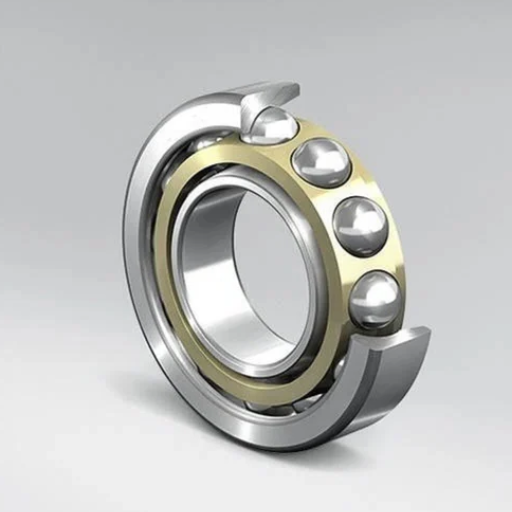
Use in machine tool spindles
Because of their capacity to handle combined axial and radial loads and their high-speed rotating capability, angular contact ball bearings are among the most critical components in machine tool spindles. These bearings facilitate the requisite accuracy in positioning, as well as the required rotational accuracy in mac hinting operations. In such operations, for instance, machine tool spindle speeds go beyond 10,000 RPM, thus the contact area of the bearings is required to be very small to avoid or reduce wear and tear by heating.
- Rotational Speed (RPM): The sterling performance of all machinery is based on the high speed at which they operate, bearings to come with no fail on these high speeds, very good at times reaching extreme, ceramic or high-speed stainless steel make up most of the bearings used during extreme speeds.
- Axial and Radial Load Capacity (N): There are usually two load types that bearings are required to cater to and they may come together while being axial, Cutting forces usually have an impact on the machining of tools.
- Preload Settings: Increasing the rigidity while maintaining the vibration at the lowest possible limit is prep loading, these are vital when attempting to sustain the accuracy of machine tools.
- Lubrication and Cooling: Oils and other lubricants are critical factors in sustaining the efficiency with them available reducing friction and strain while ensuring heat does not go beyond a certain limit.
By aligning these technical with the application’s requirements, angular contact ball bearings ensure optimal functionality and longevity in machine tool spindles.
Applications in high-speed industrial equipment
CNC machines, turbines, and robotics are but a few of the amazing technologically advanced industrial machinery that utilize angular contact ball bearings due to their exceptional precision, support for high rotation speeds, and capability of bearing both axial and radial loads. These bearings are used to minimize operational downtimes maximizing the durability of the equipment.
- Axial Load Handling: In the CNC machining industry mechanical components applying heavy cutting forces are prevalent and during their use, the aforementioned bearings hold outstanding properties concerning stress stability.
- Preload Optimization: For machinery that operates at high speeds, maintaining precise movements is a tricky feat to accomplish, and to combat the reluctance that these machines generate, I would advise presetting the preload settings as this would help in maintaining the rigidity of the machinery.
- Lubrication Requirements: Overheating in high-performing industrial machinery is a common concern, using high-quality grease or oil can significantly minimize friction and in doing so prevent the machinery from overheating, however, caution needs to be taken about the temperature limits and viscosity ratings.
- Speed Capability: It is important to ensure that the bearings intended for use have speed factors that match or exceed the required operating limits, this will guarantee the reliability of the machinery.
It is imperative to utilize the correct type of angular contact ball bearings and adhere to a maintenance schedule to maximize the performance of the machinery while increasing its lifespan in high-speed industrial scenarios.
Role in precision instruments and robotics
Angular contact ball bearings are key features of precision instruments, robotics, and other similar applications because they are efficient in defining a prominent axial and radial load while at the same time being accurate. These bearings also provide low friction, low vibration, and greater control which are essential in precision positioning or repeatable movements such as those found in robotic arms, CNC machines, or laboratory equipment.
- Bearing accuracy: For the requirements of high-precision machinery, the bearing is normally rated ISO P4 or ABEC-7/9.
- Bearing preload: They ensure that there is an optimal level of preload which can range from light to medium or even heavy but ideal levels are suited in between reducing deflection and increasing rigidity without overstressing the machine or bearing with heat.
- Bearing material: There is consistent use of Hybrid ceramic bearings which are significantly preferable to steel when talking about thermal expansion and rigidity.
- Bearing dmN value: Always analyze the operation requirements of system joints, if it is a robotic joint or a spindle system they have higher speed requirements, hence the dmN value will change accordingly.
- Bearing lubrication: Use either grease or oil but ensure that it is low viscosity and maintain a consistent users bearing.
By aligning them with the specific application requirements, I can confidently recommend and justify bearing choices for optimal functionality in precision environments.
How to maintain and extend the life of angular contact ball bearings?
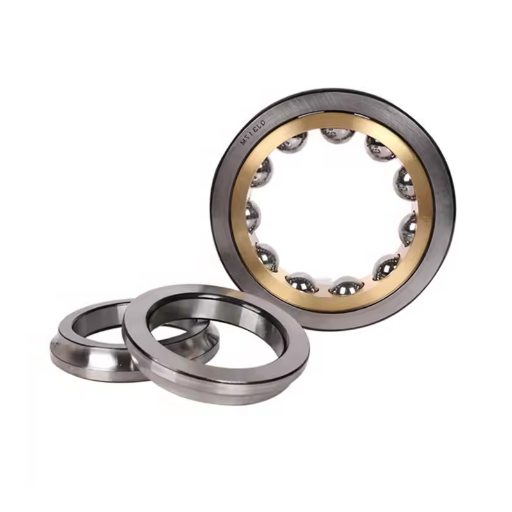
Proper lubrication techniques
Appropriate lubrication is without a doubt essential in upholding and increasing the life of angular contact ball bearings. Lubricants should always be used in the appropriate quantity depending on the working conditions. For example:
- Lubricant Type: Good quality grease or low-viscosity oils are recommended to lower internal friction and heat generation. For quick applications low viscosity synthetic oils are preferred as these oils reduce resistance and ensure proper lubrication.
- Lubricant Quantity: The correct lubricant volume is critical. Too much lubrication would result in overheating whereas too little lubricant would lead to increased wear and reduce the lifespan of the bearing.
- Re-lubrication Intervals: Larger bearings using re-lubrication would have longer intervals and the loader and operating velocity play a large role in the spacing as well. The load and rotation speed of the bearing and the environment greatly degrades the lubricant therefore adaption is required in these cases.
- Temperature Balance: The selected lubricants should range within a temperature zone suitable for the shaft’s bearings working zone. However, for high-temperature situations, A Synthetic lubricant with a higher threshold would be more suitable.
By consistently monitoring and applying these, I can ensure that the angular contact ball bearings deliver maximum performance, reliability, and lifespan while minimizing downtime and the risk of failure.
Regular inspection and cleaning procedures
To maintain the optimal performance of angular contact ball bearings, I adhere to a systematic inspection and cleaning process. First, I visually inspect the bearings for signs of contamination, wear, or damage, such as discoloration or surface irregularities. This is followed by removing the bearing from its housing, ensuring no additional contaminants are introduced during disassembly. I use an appropriate solvent, such as a specialized bearing cleaner, to remove old lubricant and debris, while avoiding abrasive tools that could damage the surface integrity of the bearing.
- Surface Roughness: Smoothing out surfaces to be below the 0.3Micrometre mark to curb excess friction.
- Radial and Axial Play: Establishing that these two are within tolerances specified by the manufacturer of the component and specific to its application.
- Lubrication Condition: Monitoring film thickness for compliance with the appropriate lubricant viscosity grade.
Once the bearings are thoroughly cleaned and dried, I perform a detailed examination under magnification to detect any micro-cracks or pitting. If no damage is identified, I re-lubricate the bearings with the appropriate grease or oil, ensuring they meet the required specifications for load and operational temperature. By following these steps, I can systematically address wear and extend the service life of the bearings, minimizing potential failures.
Frequently Asked Questions (FAQs)
Q: What are angular contact ball bearings and how do they differ from other roller bearings?
A: Angular contact ball bearings are a type of rolling element bearings designed to handle both radial loads and axial loads. They differ from cylindrical roller bearings in that they can support axial loads in one direction due to their angled raceways. This design allows for higher precision and speed capabilities compared to other types of bearings.
Q: How do angular contact ball bearings support axial loads?
A: Angular contact ball bearings are designed to handle axial loads through their angled raceways. The angle of contact between the balls and the raceways allows the bearing to accommodate axial forces effectively. Depending on the design, these bearings can support axial loads in either direction, making them versatile for various applications.
Q: What is the significance of the outer ring in angular contact ball bearings?
A: The outer ring of angular contact ball bearings plays a crucial role in their functionality. It provides one of the raceways for the balls and helps distribute the load. The design of the outer ring, along with the inner ring, determines the contact angle, which affects the bearing’s ability to handle different types of loads and its overall performance.
Q: How do angular contact ball bearings compare to tapered roller bearings?
A: While both angular contact ball bearings and tapered roller bearings can handle combined loads, they have distinct differences. Angular ball bearings offer higher speed capabilities and precision due to their point contact design. Tapered roller bearings, on the other hand, have a larger contact area, making them better suited for heavier loads but at lower speeds.
Q: What are duplex angular contact ball bearings?
A: Duplex angular contact ball bearings are a pair of angular contact bearings arranged back-to-back or face-to-face. This configuration allows the bearings to support axial loads in either direction and provides increased rigidity. Duplex bearings are typically used in applications requiring high precision and the ability to handle complex load combinations.
Q: What industries commonly use angular contact ball bearings?
A: Angular contact ball bearings are widely used in various industries due to their versatility and performance. They are typically used in machine tools, aerospace applications, industrial pumps, and high-speed turbines.
Q: How are angular contact ball bearings adjusted for optimal performance?
A: Angular contact ball bearings can be adjusted against a second bearing to achieve the desired preload and clearance. This adjustment is crucial for optimizing performance, reducing vibration, and ensuring proper load distribution. The specific adjustment method may vary depending on the application and the bearing design.
Q: What are the advantages of using angular contact ball bearings?
A: Angular contact ball bearings offer several advantages, including their ability to handle both radial and axial loads, high-speed capabilities, and precision. They also provide lower friction compared to some other bearing types, which results in reduced heat generation and improved efficiency. These bearings are designed to maintain accuracy and rigidity under various operating conditions.

